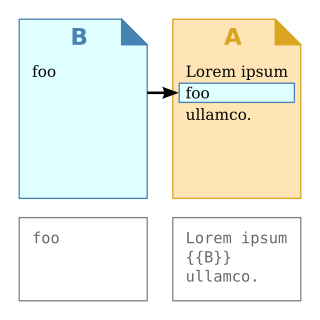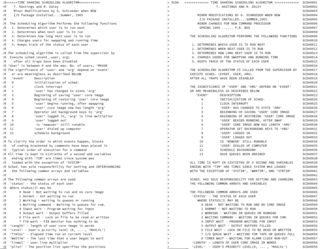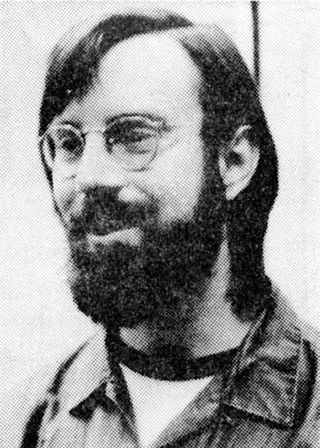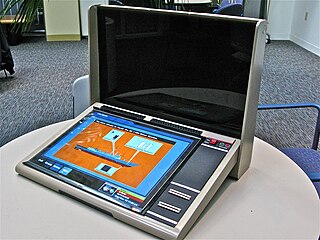
Hypertext is text displayed on a computer display or other electronic devices with references (hyperlinks) to other text that the reader can immediately access. Hypertext documents are interconnected by hyperlinks, which are typically activated by a mouse click, keypress set, or screen touch. Apart from text, the term "hypertext" is also sometimes used to describe tables, images, and other presentational content formats with integrated hyperlinks. Hypertext is one of the key underlying concepts of the World Wide Web, where Web pages are often written in the Hypertext Markup Language (HTML). As implemented on the Web, hypertext enables the easy-to-use publication of information over the Internet.

In computer science, transclusion is the inclusion of part or all of an electronic document into one or more other documents by reference via hypertext. Transclusion is usually performed when the referencing document is displayed, and is normally automatic and transparent to the end user. The result of transclusion is a single integrated document made of parts assembled dynamically from separate sources, possibly stored on different computers in disparate places.

Memex [memory expansion] is a hypothetical electromechanical device for interacting with microform documents and described in Vannevar Bush's 1945 article "As We May Think". Bush envisioned the memex as a device in which individuals would compress and store all of their books, records, and communications, "mechanized so that it may be consulted with exceeding speed and flexibility". The individual was supposed to use the memex as an automatic personal filing system, making the memex "an enlarged intimate supplement to his memory".

Theodor Holm Nelson is an American pioneer of information technology, philosopher, and sociologist. He coined the terms hypertext and hypermedia in 1963 and published them in 1965. According to a 1997 Forbes profile, Nelson "sees himself as a literary romantic, like a Cyrano de Bergerac, or 'the Orson Welles of software'."
Project Xanadu was the first hypertext project, founded in 1960 by Ted Nelson. Administrators of Project Xanadu have declared it superior to the World Wide Web, with the mission statement: "Today's popular software simulates paper. The World Wide Web trivialises our original hypertext model with one-way ever-breaking links and no management of version or contents."
e-text is a general term for any document that is read in digital form, and especially a document that is mainly text. For example, a computer-based book of art with minimal text, or a set of photographs or scans of pages, would not usually be called an "e-text". An e-text may be a binary or a plain text file, viewed with any open source or proprietary software. An e-text may have markup or other formatting information, or not. An e-text may be an electronic edition of a work originally composed or published in other media, or may be created in electronic form originally. The term is usually synonymous with e-book.

The Compatible Time-Sharing System (CTSS) was the first general purpose time-sharing operating system. Compatible Time Sharing referred to time sharing which was compatible with batch processing; it could offer both time sharing and batch processing concurrently.
This article presents a timeline of hypertext technology, including "hypermedia" and related human–computer interaction projects and developments from 1945 on. The term hypertext is credited to the author and philosopher Ted Nelson.
Guide was a hypertext system developed by Peter J. Brown at the University of Kent in 1982. The original Guide implementation was for Three Rivers PERQ workstations running Unix. The Guide system became the third hypertext system to be sold commercially, marketed by Office Workstations Ltd (OWL) in 1984 and later by InfoAccess. It won Brown the British Computer Society's award for technical innovation in 1988. He retired in 1999 and died of cancer in 2007, according to a tribute page at the University of Kent website.

Bob Wallace was an American software developer, programmer and the ninth Microsoft employee. He was the first popular user of the term shareware, creator of the word processing program PC-Write, founder of the software company Quicksoft and an "online drug guru" who devoted much time and money into the research of psychedelic drugs.
Undo is an interaction technique which is implemented in many computer programs. It erases the last change done to the document, reverting it to an older state. In some more advanced programs, such as graphic processing, undo will negate the last command done to the file being edited. With the possibility of undo, users can explore and work without fear of making mistakes, because they can easily be undone.

Andries "Andy" van Dam is a Dutch-American professor of computer science and former vice-president for research at Brown University in Providence, Rhode Island. Together with Ted Nelson he contributed to the first hypertext system, Hypertext Editing System (HES) in the late 1960s. He co-authored Computer Graphics: Principles and Practice along with J.D. Foley, S.K. Feiner, and John Hughes. He also co-founded the precursor of the ACM SIGGRAPH conference.

Computer Lib/Dream Machines is a 1974 book by Ted Nelson, printed as a two-front-cover paperback to indicate its "intertwingled" nature. Originally self-published by Nelson, it was republished with a foreword by Stewart Brand in 1987 by Microsoft Press.
Roger Everett Gregory is a US computer programmer, technologist, and scientist. Gregory's work in project Xanadu made him one of the earliest pioneers of hypertext technology, which helped lay the foundations for the hyperlink technology that underlies the World Wide Web. Gregory attended the University of Michigan as a mathematics major. In the 1970s, he founded the Ann Arbor Computer Club, similar to the West Coast's Home Brew Computer Club.

The Electronic Document System (EDS) was an early hypertext system – also known as the Interactive Graphical Documents (IGD) hypermedia system – focused on creation of interactive documents such as equipment repair manuals or computer-aided instruction texts with embedded links and graphics. EDS was a 1978–1981 research project at Brown University by Steven Feiner, Sandor Nagy and Andries van Dam.
DynaText is an SGML publishing tool. It was introduced in 1990, and was the first system to handle arbitrarily large SGML documents, and to render them according to multiple style-sheets that could be switched at will.

Hypertext is text displayed on a computer or other electronic device with references (hyperlinks) to other text that the reader can immediately access, usually by a mouse click or keypress sequence. Early conceptions of hypertext defined it as text that could be connected by a linking system to a range of other documents that were stored outside that text. In 1934 Belgian bibliographer, Paul Otlet, developed a blueprint for links that telescoped out from hypertext electrically to allow readers to access documents, books, photographs, and so on, stored anywhere in the world.

The File Retrieval and Editing SyStem, or FRESS, was a hypertext system developed at Brown University starting in 1968 by Andries van Dam and his students, including Bob Wallace. It was the first hypertext system to run on readily available commercial hardware and OS. It is also possibly the first computer-based system to have had an "undo" feature for quickly correcting small editing or navigational mistakes.

The Brown University Computing Laboratory is an academic building of Brown University located at 180 George Street in Providence, Rhode Island. It was built in 1960 and designed by noted architect Philip Johnson. The building was funded through a donation by the family of Thomas J. Watson, Sr. and dedicated to his memory. It was designed to house the IBM 7070 that was obtained through grants from the National Science Foundation and the IBM Corporation. On a wall in the main lobby hangs a tapestry given by Philip Johnson after a design by Arshile Gorky. The building was dedicated on January 12, 1961.
Norman K. Meyrowitz is a computer scientist and software executive who has led the design and development of multiple hypertext and multimedia software systems. He is an adjunct professor of the Practice of Computer Science at Brown University.











